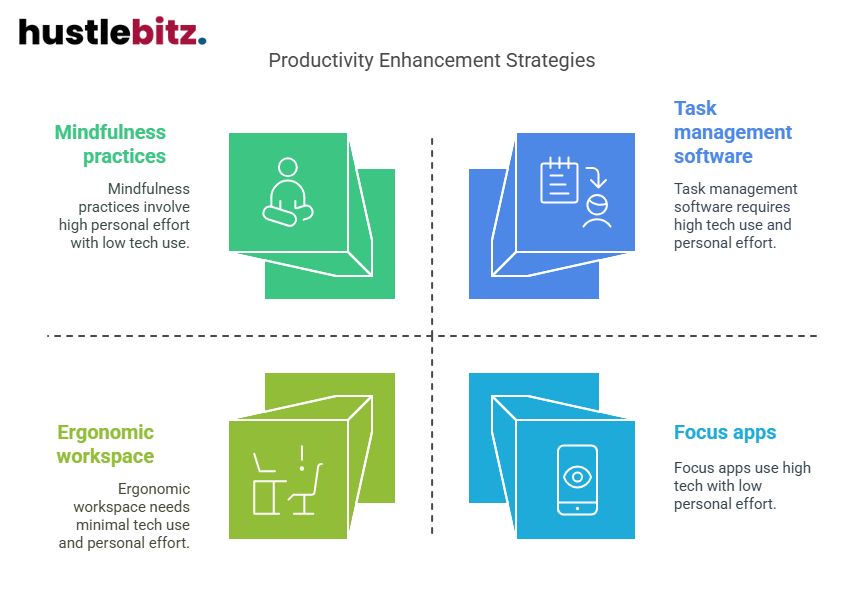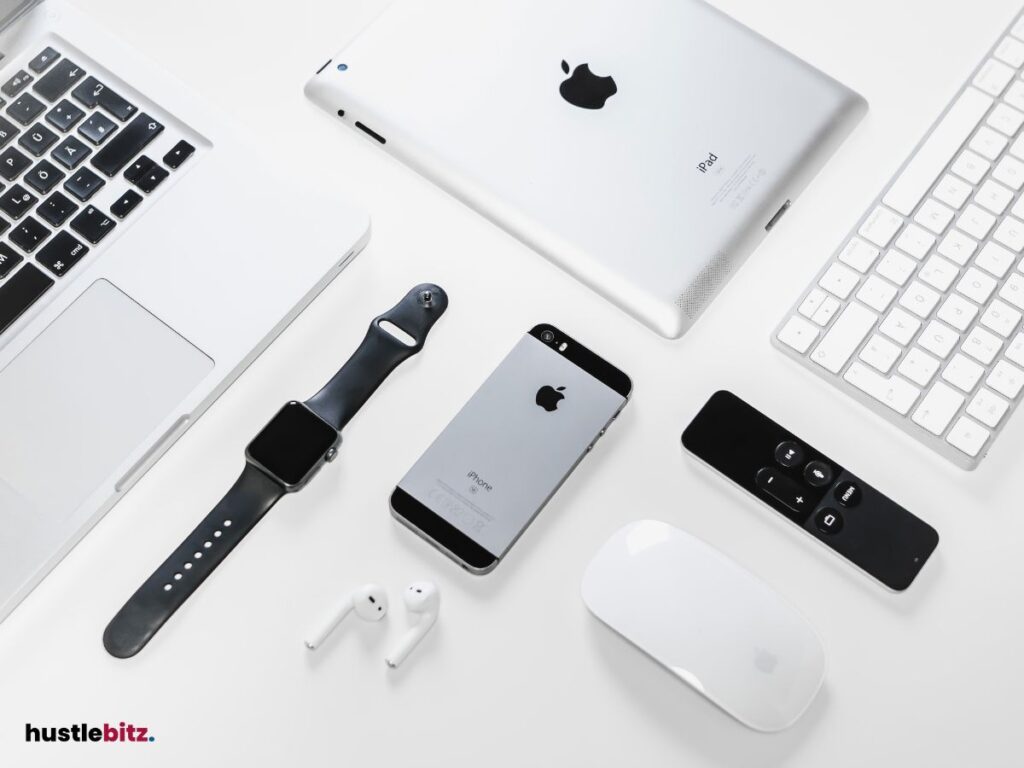Maximizing productivity hinges on enhancing focus through deliberate strategies and effective workspace management. Prioritizing attention management allows you to concentrate on high-priority tasks while minimizing common distractions like social media and office noise. Implementing mindfulness techniques and time-blocking can significantly improve mental clarity and task execution. A well-organized workspace, complemented by usage of productivity tools, further fosters concentration. Additionally, taking mindful breaks rejuvenates the mind and boosts efficiency. These strategies not only enhance focus but also contribute to a healthier work-life balance. For deeper insights into optimizing your productivity, explore additional strategies and tips.
Key Takeaways
- Implement time blocking to allocate specific periods for high-priority tasks, enhancing focus and minimizing distractions.
- Adopt mindfulness practices to improve concentration and reduce stress levels throughout the workday.
- Create a focused workspace with ergonomic furniture and minimal decor to eliminate visual distractions and promote sustained attention.
- Utilize technology, such as task management software and focus apps, to organize tasks and limit non-work-related interruptions.
- Schedule regular mindful breaks to rejuvenate the mind, boost creativity, and support overall productivity.

Understanding Focus and Productivity

Understanding the interplay between focus and productivity is essential for optimizing performance in the workplace. Effective attention management is crucial as it allows individuals to concentrate on high-priority tasks while minimizing cognitive load. When employees harness mental clarity, they can set realistic goals that align with organizational objectives, fostering a sense of purpose and motivation.
Incorporating time blocking into daily routines serves as a practical approach to managing tasks efficiently. By allocating specific time periods for concentrated work, individuals can enhance their focus and reduce distractions. Furthermore, mindfulness practices can play a pivotal role in improving concentration by promoting a present-focused mindset that mitigates stress and enhances overall well-being.
Employing prioritization strategies is equally important. By identifying and ranking tasks based on their significance and deadlines, employees can ensure that they are dedicating their energies to the most impactful activities. Additionally, motivation techniques, such as positive reinforcement and self-assessment, encourage continuous improvement and sustained effort.
Task delegation is another vital component in maximizing productivity. By empowering team members to take ownership of specific responsibilities, leaders can enhance collective focus and ensure that energy levels are utilized efficiently. Ultimately, understanding how to balance focus with productivity equips individuals and organizations with the tools necessary to achieve their objectives while fostering a culture of engagement and high performance.
Identifying Common Distractions

Several common distractions in the workplace can significantly hinder productivity, including digital interruptions, environmental noise, and multitasking demands. Identifying these distractions is crucial for improving time management and enhancing focus.
Among the most prevalent distractions are:
- Social Media: The temptation to check notifications or engage in conversations can lead to significant time loss and emotional stress.
- Office Noise: Environmental factors such as conversations, phone calls, or general office activities can disrupt concentration and lead to decreased efficiency.
- Digital Clutter: An overwhelming amount of emails, notifications, and online distractions can make it challenging to maintain task prioritization and focus.
Additionally, personal distractions like family responsibilities or health issues can further complicate work-life balance.
Many individuals fall into multitasking habits, mistakenly believing that switching between tasks will lead to greater productivity. However, this often results in decreased performance and increased emotional stress.
Recognizing these distractions enables professionals to take proactive steps towards creating a more conducive work environment.
Productivity Through Focus

Achieving heightened productivity hinges on an individual’s ability to maintain focus amidst the myriad distractions that permeate the modern workplace. To cultivate this focus, implementing mindfulness techniques can be particularly effective. Mindfulness encourages individuals to remain present, enhancing their ability to concentrate on the task at hand.
Goal setting is another critical component. Clearly defined objectives provide direction and motivation, allowing individuals to prioritize tasks effectively. By honing prioritization skills, workers can allocate their time to the most impactful activities, thus optimizing their energy levels throughout the day. Effective time management techniques, including task batching, can further enhance productivity by grouping similar tasks together, minimizing context switching, and maximizing concentration.
In addition, fostering a healthy work-life balance plays a pivotal role in sustaining focus. Individuals who maintain this balance are likelier to experience higher energy levels and mental resilience, essential for overcoming workplace challenges. Utilizing motivation strategies, such as rewarding oneself for completing tasks, can also bolster focus and productivity.
Engaging with accountability partners can provide an additional layer of support. By sharing goals and progress with others, individuals are more likely to stay on track and remain committed to their objectives. This communal approach not only enhances individual focus but also promotes a culture of productivity within teams.
Creating a Focused Workspace
A well-organized workspace is essential for fostering concentration and minimizing distractions, ultimately enhancing overall productivity. To create an environment conducive to focus, several key elements should be considered in the workspace layout.
Firstly, the integration of ergonomic furniture is vital. This not only promotes physical comfort but also encourages sustained attention by reducing body strain. Additionally, incorporating natural lighting can significantly improve mood and energy levels, making the workspace feel more inviting.
Moreover, adopting minimalist decor helps eliminate visual clutter, allowing the mind to concentrate on the task at hand. Decluttering strategies can further enhance this effect, ensuring that only essential items occupy your personal space.
To enhance the overall ambiance, consider the following actionable ideas:
- Noise Control: Install sound-absorbing materials or use noise-canceling headphones to minimize distractions.
- Plant Integration: Introduce greenery into your workspace; plants can boost creativity and improve air quality.
- Color Psychology: Use colors that inspire focus; for instance, blues and greens can promote calmness and concentration.
Lastly, displaying inspirational quotes can serve as motivation throughout the day. A thoughtfully designed workspace, characterized by these elements, not only supports productivity but also nurtures a positive mindset, ultimately leading to better performance.
Utilizing Technology Wisely

Leveraging technology effectively can significantly enhance focus and productivity in the workplace. By incorporating the right digital tools, organizations can streamline workflows and foster a more focused environment. Task management software is essential for organizing projects and prioritizing tasks, ensuring that employees remain aligned with their objectives.
Focus apps can aid individuals in minimizing distractions, while productivity software often integrates time tracking features that help users monitor their work hours and identify peak productivity periods. For teams, virtual collaboration platforms enable seamless communication, facilitating real-time updates and discussions that keep everyone engaged and on track.
Implementing distraction blockers can further enhance focus by limiting access to non-work-related content during critical work periods. Coupled with mindfulness techniques, such as scheduled breaks for brief meditation, employees can maintain their mental clarity and resilience.
In addition, automation solutions can take over repetitive tasks, allowing staff to concentrate on more strategic activities that require their expertise. Moreover, ergonomic setups, including adjustable desks and supportive seating, promote physical well-being, which is crucial for maintaining concentration over extended periods.
Ultimately, utilizing technology wisely not only amplifies productivity but also contributes to a healthier work-life balance. By thoughtfully integrating these tools and techniques, organizations can cultivate an environment where focus thrives, leading to enhanced job satisfaction and overall success.
Taking Breaks Effectively
How can taking breaks effectively enhance overall productivity and focus in the workplace? Incorporating mindful breaks into your daily routine not only rejuvenates the mind but also boosts creativity and efficiency. Scheduled downtime allows employees to recharge and return to their tasks with renewed energy and focus.
To maximize the benefits of breaks, consider the following strategies:
- Engage in Physical Activity: Incorporating short bursts of exercise during breaks can invigorate the body and mind. Simple stretching or a quick walk can enhance circulation and cognitive function.
- Nature Exposure: Spending time outdoors offers a refreshing escape from the indoor environment. Nature exposure has been shown to reduce stress and improve mood, thereby enhancing overall productivity.
- Digital Detox: Disconnecting from screens, even briefly, helps alleviate mental fatigue. Use this time for relaxation techniques such as breathing exercises or engaging in creative activities that foster innovation.
Time management is crucial when planning these breaks; ensure they are integrated seamlessly into your work schedule to maintain productivity.
By fostering social connections during breaks, employees can enhance their collaboration skills and create a more cohesive work environment.
Ultimately, taking breaks effectively is not merely a luxury but a necessity for sustaining focus and productivity in the workplace. By prioritizing mindful breaks, organizations can cultivate a healthier, more engaged workforce.
Final Thoughts
Maximizing productivity is about more than just working harder—it’s about working smarter by sharpening your focus. By integrating mindfulness, time management strategies, and a well-organized workspace, you can enhance your concentration and efficiency. Utilizing technology wisely and taking mindful breaks not only supports mental clarity but also boosts overall performance. When you combine these tactics, you’ll not only accomplish more but also maintain a healthier, more sustainable work-life balance.




